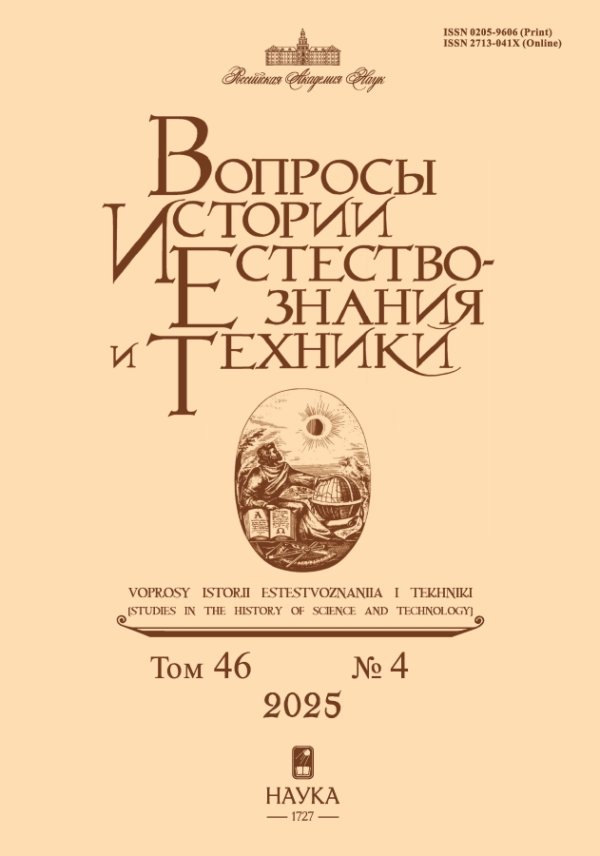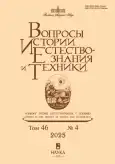Studies in the History of Science and Technology
The peer-review journal Voprosy istorii estestvoznaniia i tekhniki (VIET) ["Studies in the History of Science and Technology"] journal was founded in 1980 on the basis of an irregularly published collection of works by employees of the Institute for the History of Science and Technology of the Academy of Sciences of the USSR (IHST of the USSR Academy of Sciences).
Founders
- Russian Academy of Sciences
- Institute for the History of Science and Technology
Publisher
- Russian Academy of Sciences
About the journal
The main block of the journal's materials is formed by original articles presenting research results of qualified specialists in the history and philosophy of science and technology. The scientific level of the results and the compliance of articles with publication standards is ensured by a representative editorial board, which includes two academicians (RAS), one corresponding member of the RAS, doctors and candidates of sciences.
The contents of the journal are divided into main sections reflecting the scope and specifics of the proposed scientific publications:
- General Problems of the History of Science and Technology
- From the History of Science
- Social History of Science
- From the History of Technology
- Lessons from History
- Materials for the Biographies of Scientists and Engineers
- Institutions and Museums
- Sources for the History of Science and Technology
The information block contains memoirs, reviews, books reviews, annotations for defended dissertations, as well as information about past conferences and correspondence with readers.
The journal is published quarterly and is included in the "List of peer-reviewed scientific publications" of the Higher Attestation Commission of Russian Federation and the Russian Science Citation Index in Web of Science.
Media registration certificate: № 0110149 от 04.02.1993
Current Issue
Vol 46, No 4 (2025)
From the History of Science
ICE STRENGTH STUDIES IN PRE-REVOLUTIONARY RUSSIA
Abstract
 601–616
601–616


TYPOLOGY OF LAKES IN THE RUSSIAN EMPIRE BEFORE E. NAUMANN (ON THE OCCASION OF 105TH ANNIVERSARY OF PUBLICATION OF “FUNDAMENTALS OF FISHERY VALUATION OF LAKES” BY M. P. SOMOV)
Abstract
 617–633
617–633


Social History of Science
AN UNREALIZED COOPERATION BETWEEN A. N. SEVERTSOV INSTITUTE OF EVOLUTIONARY MORPHOLOGY AND ECOLOGY OF ANIMALS OF THE USSR ACADEMY OF SCIENCES AND FRENCH BIOLOGISTS IN THE FIELD OF DOLPHINS’ BIOACOUSTICS
Abstract
 634–646
634–646


From the History of Technology
THE ROLE OF SCIENCE IN THE CREATION OF AN AIRPLANE
Abstract
 647–689
647–689


Materials for the Biographies of Scientists and Engineers
A. V. PEIYE’S SCIENTIFIC VISITS TO EASTERN EUROPEAN COUNTRIES IN THE 1960s – 1980s
Abstract
 690–713
690–713


PROFESSOR A. P. RUDENKO, CREATOR OF THE THEORY OF EVOLUTIONARY CATALYSIS (IN COMMEMORATION OF THE CENTENARY OF HIS BIRTH)
Abstract
 714–738
714–738


A. Ch. ALBRECHT, CRAFTSMAN AT ST. PETERSBURG UNIVERSITY, AND AN INSTRUMENT OF HIS MAKING FROM PETER THE GREAT MUSEUM OF ANTHROPOLOGY AND ETHNOGRAPHY (THE KUNSTKAMERA) OF THE RUSSIAN ACADEMY OF SCIENCES
Abstract
 739–751
739–751


N. I. EVGENOV – PARTICIPANT AND LEADER OF THE KARA EXPEDITIONS IN 1925–1931
Abstract
 752-774
752-774


Sources for the History of Science and Technology
V. V. Stanchinskii's Letters to Academician V. I. Vernadsky
Abstract
 775-789
775-789


AERONAUTICAL ENGINEER I. I. SIKORSKY'S CORRESPONDENCE WITH E. A. VECHORIN IN THE COLLECTIONS OF THE BAKHMETEFF ARCHIVE AT COLUMBIA UNIVERSITY (NEW YORK, USA)
Abstract
 790-805
790-805


Essay Review
NEBESNOE STADO U ISTOKOV ASTRONOMII: ChITAYa KNIGU G. E. KURTIKA «OChERKI ISTORII ShUMERSKOY ASTRONOMII»
 806–821
806–821


Book Reviews
EVERSMAN E. PUTEShESTVIE IZ ORENBURGA V BUKhARU. ORENBURG: ORENBURGSKOE KNIZhNOE IZDATEL'STVO im. G. P. DONKOVTsEVA, 2023. 288 s. ISBN 978-5-88788-288-8
 822–826
822–826


Books in Brief
Books in Brief
 827–830
827–830


Academic Life
SEKTsIYa «ZhENShchINY-UChENYE I PREPODAVATEL'NITsY SREDNEY I VYSShEY ShKOLY V GODY REVOLYuTsIY, VOYN, VYNUZhDENNYKh MIGRATsIY I INYKh SOTsIAL'NYKh KATAKLIZMOV» NA XVIII MEZhDUNARODNOY NAUChNOY KONFERENTsII ROSSIYSKOY ASSOTsIATsII ISSLEDOVATELEY ZhENSKOY ISTORII
 831–836
831–836


Events in Brief
Events in Brief
 837-839
837-839


Essay Index
Essay Index, 2025
 840-843
840-843


Author Index
Author Index, 2025
 844
844












